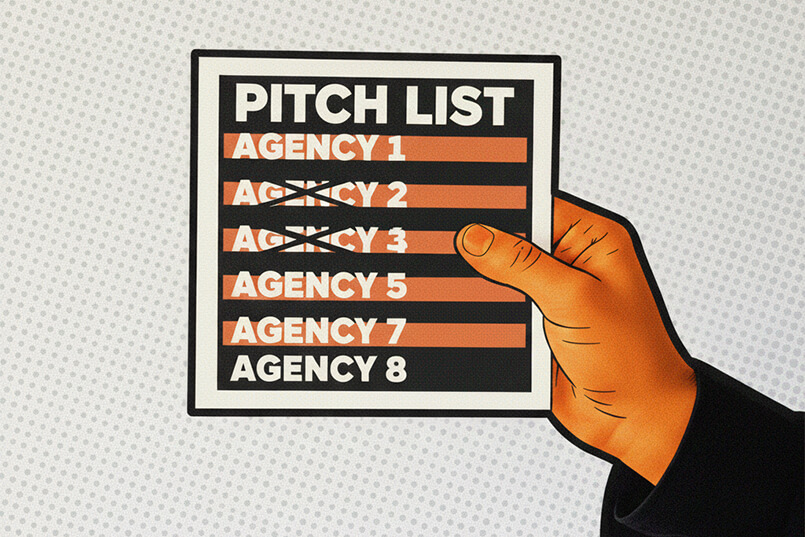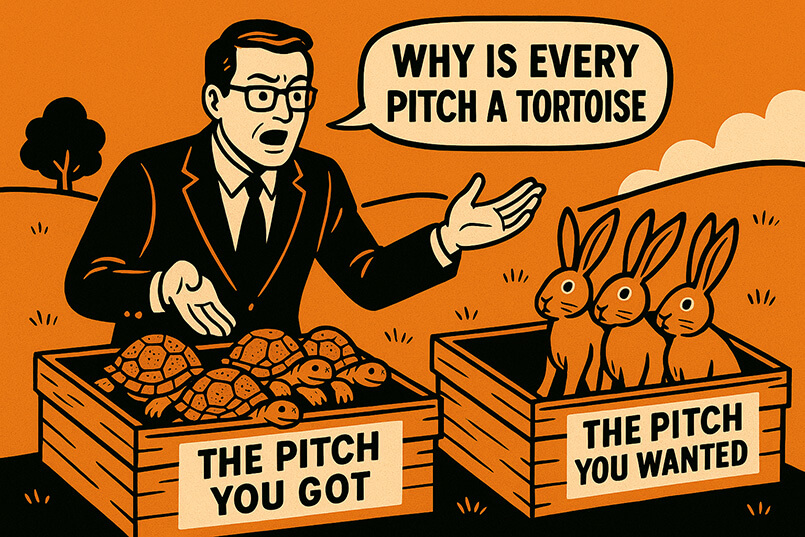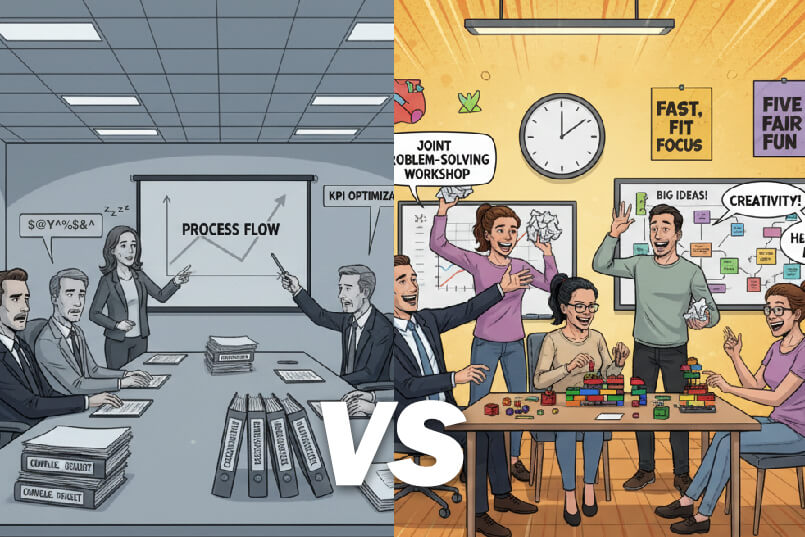When the advertising industry refers to a pitch being broken, it typically means one of the two most common tender processes used in advertising today.
- The Standard Agency Pitch Management Process.
- The Standard Procurement Managed Tender Process.
An outline of these can be seen and reviewed below. The process is robust and diligent, yet essentially flawed in the 21st century of marketing, media, and advertising.
Designed for a period when agencies provided advertising and media solutions, and advertisers sought an Agency of Record (AoR) to become a marketing partner.
However, today, most advertisers have certain agency services in-house, ranging from design to content creation, media, and more. Agencies now offer a wide range of services across various media channels and disciplines, or are specialised agencies with deep expertise and experience in one or more of these areas. Additionally, technology is significantly influencing these relationships and considerations through AI automation, generative AI, and more.
The current standard approaches are flawed because they rely on testing with speculative work and media rates, which is too narrow a measure of the increased and complex factors involved when choosing a marketing agency vendor.
The Broken Agency Pitch Management Process?
A process for selecting an advertising agency through a pitch or tender:
1. Preparation & Briefing:
Define Needs: Clearly outline objectives, scope of work (services required, deliverables), target audience, and budget.
Assemble Team: Form a small, cross-functional internal team.
Create Brief/RFP: Develop a comprehensive document detailing your needs, challenges, project specifics, timeline, and evaluation criteria.
2. Agency Identification & Shortlisting:
Longlist Agencies: Research and identify a broad list (6-10) of potential agencies based on reputation, specialisation, and recommendations.
Initial Credentialing (RFI): Send a brief Request for Information to the longlist to assess basic capabilities and experience.
Shortlist & Chemistry: Narrow down to 3-5 agencies and conduct informal “chemistry meetings” to assess cultural fit.
3. Proposal & Presentation:
Issue RFP: Send the detailed brief to the shortlisted agencies. Conduct a Q&A session.
Receive Proposals: Agencies submit their strategic, creative, and financial proposals.
Evaluate & Select Finalists: Review proposals against your criteria. Select 2-3 agencies for final presentations.
Pitch Presentations: Agencies present their solutions in person, elaborating on their strategies and concepts.
4. Decision & Onboarding:
Reference Checks: Contact past clients of the top contender(s).
Commercial Negotiation: Discuss and finalise financial and contractual terms.
Final Decision: Make the selection and inform all participating agencies.
Contracting & Kick-off: Sign the agreement and begin the onboarding process.
The Broken Procurement Managed Tender Process?
The procurement process for selecting an advertising or media agency, broken down into essential steps:
1. Define Needs & Strategy: Clearly articulate why a new agency is needed, define the scope of work (services required), set measurable objectives (KPIs), and establish the budget. Align internally with all stakeholders.
2. Market Research & Shortlisting: Research potential agencies, identify those with relevant expertise and experience, and create a long-list. Conduct initial vetting (optional: RFI/EOI) to create a shortlist.
3. Develop & Release RFP: Create a comprehensive Request for Proposal (RFP) detailing your brief, evaluation criteria, submission requirements, commercial expectations, and a clear timeline. Release it to the shortlisted agencies.
4. Manage Q&A & Receive Proposals: Establish a formal process for agencies to ask questions and receive clear, consistent answers. Collect all submitted proposals by the deadline.
5. Evaluate Proposals & Shortlist: Form an evaluation committee to rigorously review and score proposals against the defined criteria. Create a refined shortlist of top contenders.
6. Pitches & Due Diligence: Invite shortlisted agencies for presentations/pitches to assess chemistry and strategic fit. Conduct thorough reference checks with their current/past clients.
7. Financial Review & Negotiation: Analyze proposed fee structures and engage in commercial negotiations with the leading agency(ies) to finalize terms and pricing.
8. Final Decision & Contract: Make the final selection, notify the successful agency (and provide feedback to others), and formalize the partnership with a comprehensive contract.
Why are these common approaches flawed?
Our State of the Pitch Research has identified five key areas where the current standard pitch process is no longer as effective as it once was, and why many in the advertising industry believe it is broken.
1. It is slow and protracted, rather than fast.
Our research indicates that the traditional pitch process can become overly lengthy and time-consuming, resulting in wasted time and resources. The cause of this can be any number of issues, such as large groups of decision makers, poor planning, and conflicting demands on marketers’ time.
The impact is that the process loses momentum and energy, agencies are left waiting for feedback and communication on next steps and may suspect that this is not a truly valued process.
A BetterPitch helps brands find the right agency partner faster by minimising wasted time and resources and focuses on what is essential.
e.g. streamlining the pitch or tender process to focus more on the evaluation of the agencies and the less on having the agencies do speculative creative work.
2. It is rarely fit for purpose.
RFPs and speculative creative or media buying exercises often focus on only one factor for choosing an agency and frequently test it in the most artificial and contrived way possible.
The impact is that agencies are often selected for a singular ability or capability, rather than across the multitude of factors required to establish a high-performing marketing relationship. This requires focusing on assessing the core competencies needed in a way that fits the task at hand.
BetterPitch ensures brands and agencies are culturally aligned and compatible for the long run, building lasting, successful partnerships.
e.g., more organised and productive face-to-face meetings, demonstrating and sharing capabilities and skills, with less written documentation beyond the need for compliance checks.
3. Compliance, governance and risk are an administrative load rather than a focus
Compliance, governance, and risk mitigation are all crucial when choosing a new marketing agency vendor. However, the RFP process demands a substantial amount of agency time and resources to meet these requirements.
Selecting the appropriate time and way of undertaking these processes is essential in delivering the desired outcome.
BetterPitch applies the discipline, rigour, governance, risk management and well-structured decision-making you expect when selecting an agency partner, without unnecessary complexity.
e.g. streamlining compliance requirements with checklists and surveys rather than completing endless RFPs.
4. It is a cookie-cutter approach when a complex market demands flexible.
In the face of increasing market complexity and the corresponding rise in demands and requirements, it is unlikely that the current standard pitch processes above can deliver the desired outcome as effectively or efficiently as possible.
Doing the same thing repeatedly and expecting a different result applies when choosing new marketing agency vendors. Not every pitch needs the same approach and should be customised to suit the purpose.
BetterPitch adapts to different business needs, making pitches more relevant, transparent and effective.
e.g. using reference checks and interviewing existing clients to get a more honest and objective view of the agency’s strengths, weaknesses and capabilities.
5. It has become dull when it should be fun
Fun should be central to great advertising and creativity, and what better way to kick off a new agency relationship than with a pitch process that encourages creativity through fun.
At some point, it seems as if the increasing complexity of the process has been added to the ways of selecting agencies without considering the implications, leading to a process burdened with administration and transactions rather than opportunities and potential.
BetterPitch makes agency selection an engaging, inspiring, and collaborative process, rather than a draining, transactional one.
e.g. making the whole process less of a performance and more collaboration opportunities between marketers and the agencies to test authenticity, cultural alignment and trust.
What does this mean in practical terms?
Here are three increasingly common scenarios to get you thinking. None of these suggestions is definitive, but are provided as an illustration of the philosophy and approach of the BetterPitch.
1. The project pitch
The marketer has a project. Either there is no incumbent, or the incumbent does not have the ability to deliver the project. There is a budget allocated and a timeline. You need an agency fast.
A standard pitch is the wrong approach here. Yet our research shows that many agencies are invited into a pitch process with no indication of the outcomes, including the size of the project. Much of the pitch effort is a waste of time as the work is created in a vacuum.
A BetterPitch could include a meeting with three recommended agencies. In each meeting, the agency presents its story using a PechaKucha-style presentation. It involves 20 slides, each shown for 20 seconds, resulting in a 6-minute and 40-second presentation.
The client could then brief their preferred agency on their requirements, budget, and timelines, and a campaign plan and timeline would be assessed. If the response is not acceptable, they would brief a second agency, and then a third agency until they find the right one. But they can never go back to a previous agency. Fast. Flexible. Fun.
2. The full-service pitch
The need to choose a full-service agency is again popular among medium- to larger-sized marketers seeking the convenience of having everything handled by a single agency. The reality is that the solution can involve a mix of different parts within one agency, parts of a network, or even separate agencies outsourced to deliver the full range of capabilities needed.
A standard pitch process would struggle to evaluate this.
A BetterPitch could adopt a more comprehensive approach to evaluating how well the full-service agency offering works by conducting a workshop that enables the marketing team to test-drive the agency’s services.
These workshops may involve not only the marketing evaluation team but also members of the broader organisation who will interact with the successful agency. Facilitated by the agency, these workshops aim to address and resolve a specific issue or problem, with the agency’s role being to gather solutions from all participants while also demonstrating their working methods and value proposition. Fit. Focused. Flexible.
3. The in-house pitch
With a greater proportion of marketing organisations building in-house agency capabilities, there is a need for a more robust approach to appointing external specialist agencies to fill the capabilities gaps in-house.
Simply appointing someone you know or like will not suffice to meet the requirements of necessary risk mitigation and due diligence. But neither does running a standard tender or pitch process, as it is often onerous compared to the opportunity.
A BetterPitch could organise a paid hackathon for the shortlisted agencies, allowing them to work collaboratively with the in-house team and compete directly with each other on a specific project.
This allows the team to see how external agencies align and work with the in-house team and marketers in a direct, side-by-side comparison. Fun. Fit. Flexible.
There is a BetterPitch
You could stick with the standard pitch and tender processes we outlined earlier. Alternatively, you might justify it by saying you’ve made minor tweaks to make it more relevant, quicker, and less wasteful. Or you can acknowledge that the marketing, media, and advertising world has been fundamentally changed by technology, and now it’s time to rethink the pitch of a BetterPitch.
This is a pitch process that is:
Fast, to maintain momentum and energy.
Fit, to select the agency capabilities you need.
Focused on minimising risk and ensuring due diligence and governance.
Flexible, with no one-size-fits-all cookie-cutter approach.
And Fun. Because this is the source of great creativity.
Discover more on the BetterPitch and how it can help run a better pitch.
Or contact us to discuss how we can help you with BetterPitch Coaching and more.




